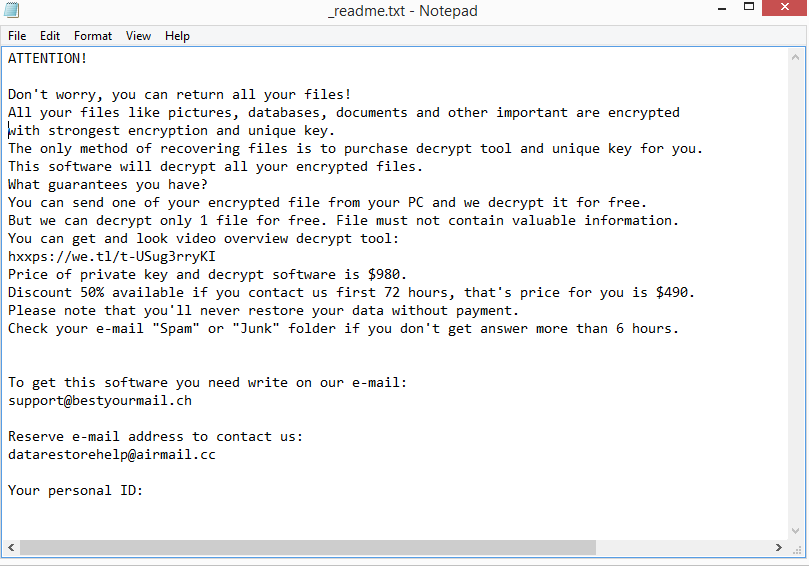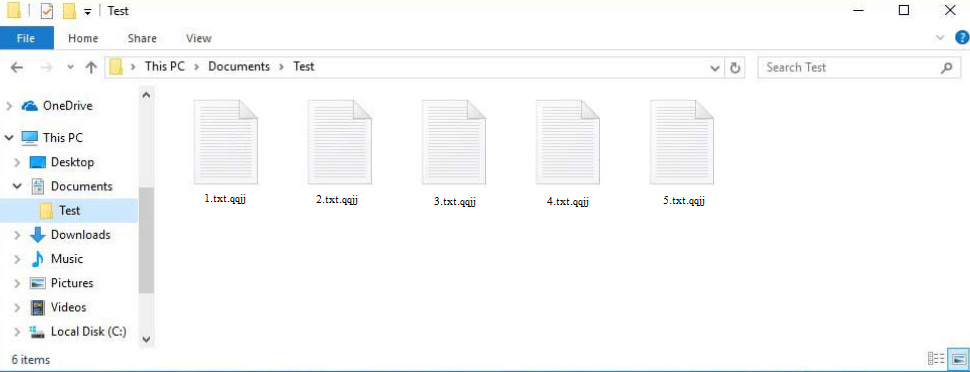Qqjj ransomware is malware that encrypts files. It’s operated by the same malicious actors behind the notorious Djvu/STOP ransomware family. Qqjj ransomware is essentially another version of this ransomware. The versions do not differ much, but you can identify which one you’re dealing with by the extension added to encrypted files. Once files are encrypted, the only way to recover them is to use a specific decryptor on them.
The ransomware targets personal files so all your photos, videos, images, documents, etc., will be encrypted. They will all have .qqjj added to them. For example, text.txt would become text.txt.qqjj if encrypted by this ransomware. Files with this extension will be unopenable unless you first use a decryptor to decrypt them. However, acquiring the decryptor can be tricky because the only people who have it are the malicious actors operating this ransomware. And they’re not generous enough to just give it to you.
You will find a _readme.txt ransom note in all folders that have encrypted files. The note is the same as the ones dropped by all ransomware in this family. But it does explain how you can get a decryptor. Unfortunately, it involves paying a ransom. The requested sum is $980 but there supposedly is a 50% discount for victims who make contact with the cybercriminals within the first 72 hours. Whether that is true is questionable but paying the ransom, in general, is not a good idea. There are no guarantees that you would be sent the decryptor considering this ransomware gang does not operate like a regular business. In the end, it’s your decision but you should be aware of the risks.
If you have a backup, you can start recovering files as soon as you remove Qqjj ransomware from your computer. Use anti-malware software to delete Qqjj ransomware, and once it’s fully gone, connect to your backup.
If you don’t have a backup and have no intention of paying the ransom, back up your encrypted files and wait for a free Qqjj ransomware decryptor to be released. It’s not uncommon for malware researchers to release free decryptors when possible. However, the issue with Qqjj ransomware and most ransomware from this family is that they use online keys to encrypt files. This means the keys are unique to each user. So for a decryptor to work for you, malware researchers would have to have your key. Unfortunately, the only people who have the encryption keys are the cybercriminals operating the malware. Unless those keys are released, a decryptor is unlikely to be released. There is a free Djvu/STOP ransomware decryptor by Emsisoft that you could try but it will only work if your files were encrypted with an offline key. If a decryptor is ever released, it would be posted on NoMoreRansom.
Ransomware distribution methods
Users whose email addresses have been compromised are often targeted by malicious emails. And one of the most typical ways users infect their devices with malware is by opening malicious email attachments. However, unless users are explicitly targeted, malicious emails are typically relatively simple to identify. They are frequently very poorly written and have many grammar and spelling errors. Because malicious senders frequently make claims to be from reliable companies, the mistakes are particularly obvious. For instance, malicious emails are often disguised to look like parcel notifications from companies like FedEx. But it’s pretty clear that an email isn’t from FedEx if it’s full of spelling and grammar errors. You will hardly ever see errors in legitimate emails, especially in ones that are automatically generated. Therefore, the first thing you should check for when you receive an unsolicited email with an attachment or a link is any grammar or spelling errors.
When you receive an unsolicited email, you should also verify the sender’s email address. It’s highly likely that you are dealing with a harmful or spam email if the email address appears to be absolutely random but the sender claims to be from a legitimate company. However, even if an email address appears to be valid, you should still look into it to determine whether the email address actually belongs to whoever the sender claims to be.
You should be cautious even if an unsolicited email appears to be legitimate because some malicious spam attempts can have much more effort put into them. This is particularly true when hackers target someone in particular. This is why it’s a good idea to run a VirusTotal or anti-virus software scan on every email attachment before opening it.
Malware is also distributed using torrents. Due to the poor regulation of many torrent websites, malicious actors are able to upload torrents with malware in them. In torrents for copyrighted content (movies, TV series, video games, software, etc.), malware is particularly prevalent. Users who don’t know how to spot malicious torrents could end up accidentally infecting their computers with serious malware. Generally speaking, torrenting copyrighted content is not a good idea because it not only poses a risk to your computer and data but also amounts to theft.
Qqjj ransomware removal
Since ransomware is a sophisticated and complex infection, it’s recommended to use anti-malware software to remove Qqjj ransomware. If you try to do it manually, you might end up causing additional damage by accident. Furthermore, it’s possible you would miss some part of the ransomware, which would allow it to recover later on. If you were connected to your backup when the ransomware recovered, your files in the backup would become encrypted as well. So it’s not only easiest but also safest to use anti-malware software to delete Qqjj ransomware. Once the ransomware is completely gone, you can safely connect to your backup and start recovering your files.
If you don’t have a backup, your only option is to wait for a free decryptor to be released. Whether it will ever be released is not certain but if you’re out of options, back up your encrypted files and store them safely. If a free Qqjj ransomware decryptor is ever released, it would become available on NoMoreRansom.
Offers
Download Removal Toolto scan for Qqjj ransomwareUse our recommended removal tool to scan for Qqjj ransomware. Trial version of provides detection of computer threats like Qqjj ransomware and assists in its removal for FREE. You can delete detected registry entries, files and processes yourself or purchase a full version.
More information about SpyWarrior and Uninstall Instructions. Please review SpyWarrior EULA and Privacy Policy. SpyWarrior scanner is free. If it detects a malware, purchase its full version to remove it.

WiperSoft Review Details WiperSoft (www.wipersoft.com) is a security tool that provides real-time security from potential threats. Nowadays, many users tend to download free software from the Intern ...
Download|more


Is MacKeeper a virus? MacKeeper is not a virus, nor is it a scam. While there are various opinions about the program on the Internet, a lot of the people who so notoriously hate the program have neve ...
Download|more


While the creators of MalwareBytes anti-malware have not been in this business for long time, they make up for it with their enthusiastic approach. Statistic from such websites like CNET shows that th ...
Download|more
Quick Menu
Step 1. Delete Qqjj ransomware using Safe Mode with Networking.
Remove Qqjj ransomware from Windows 7/Windows Vista/Windows XP
- Click on Start and select Shutdown.
- Choose Restart and click OK.

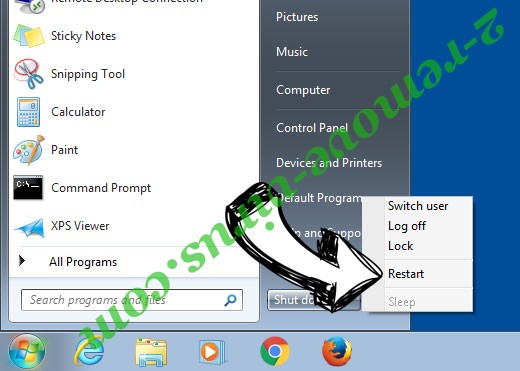
- Start tapping F8 when your PC starts loading.
- Under Advanced Boot Options, choose Safe Mode with Networking.

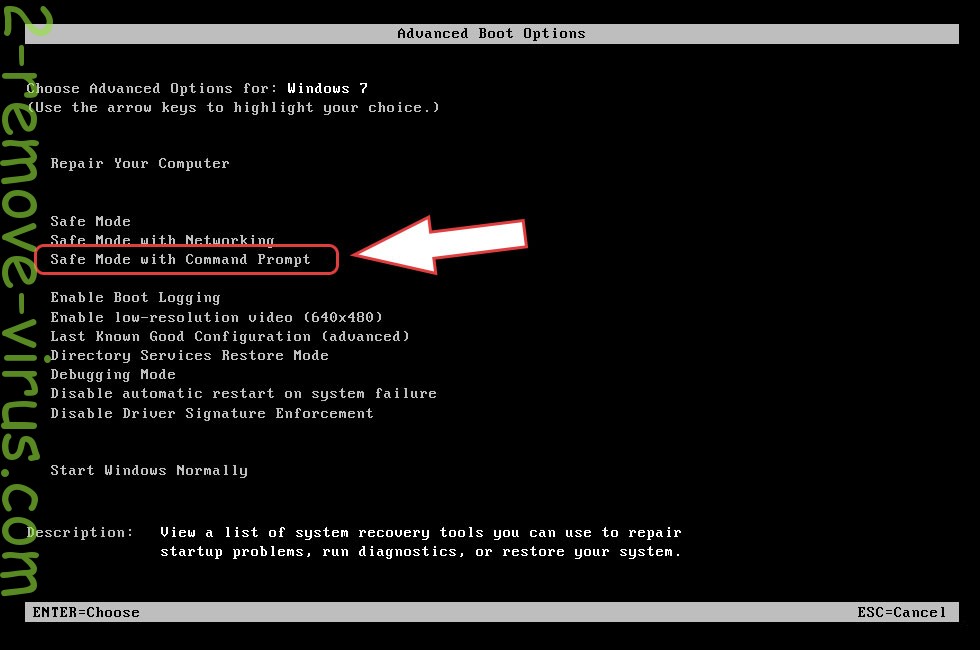
- Open your browser and download the anti-malware utility.
- Use the utility to remove Qqjj ransomware
Remove Qqjj ransomware from Windows 8/Windows 10
- On the Windows login screen, press the Power button.
- Tap and hold Shift and select Restart.

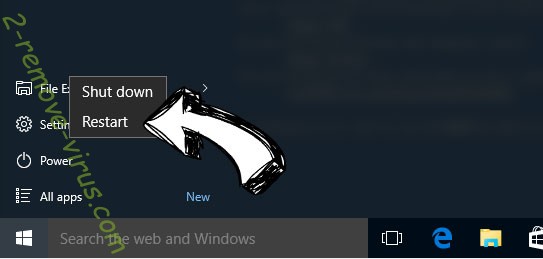
- Go to Troubleshoot → Advanced options → Start Settings.
- Choose Enable Safe Mode or Safe Mode with Networking under Startup Settings.

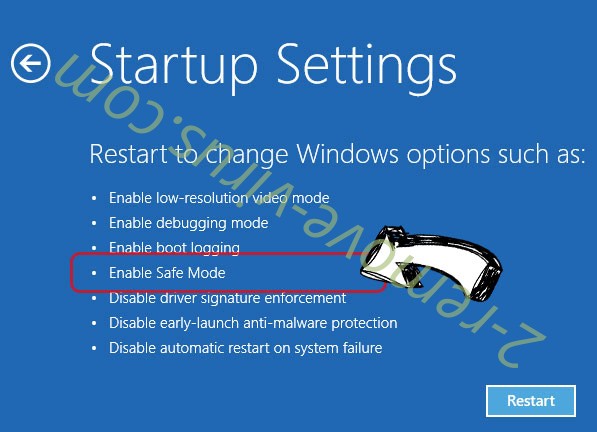
- Click Restart.
- Open your web browser and download the malware remover.
- Use the software to delete Qqjj ransomware
Step 2. Restore Your Files using System Restore
Delete Qqjj ransomware from Windows 7/Windows Vista/Windows XP
- Click Start and choose Shutdown.
- Select Restart and OK


- When your PC starts loading, press F8 repeatedly to open Advanced Boot Options
- Choose Command Prompt from the list.

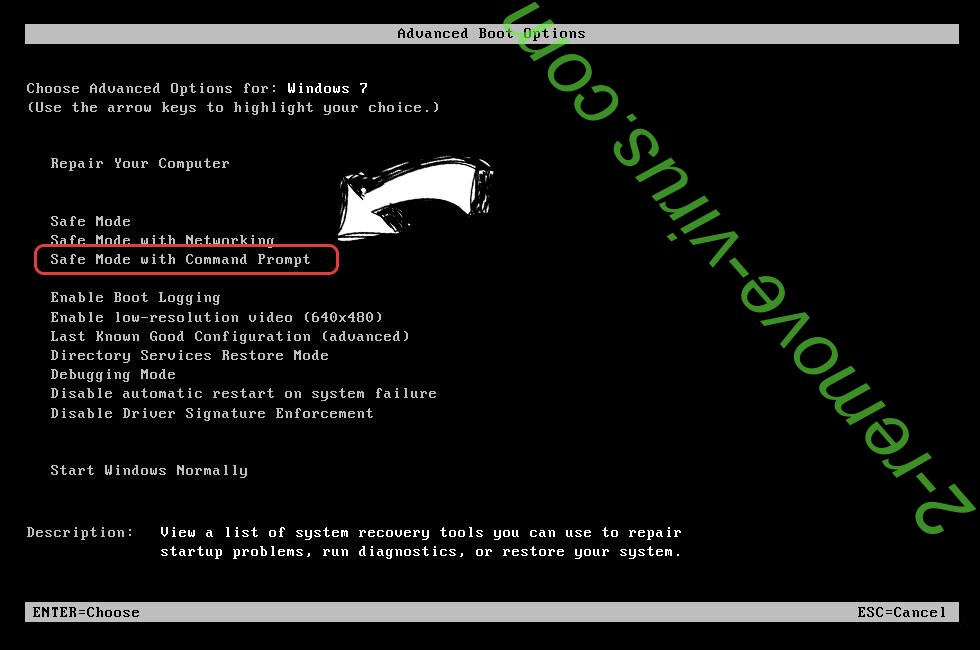
- Type in cd restore and tap Enter.

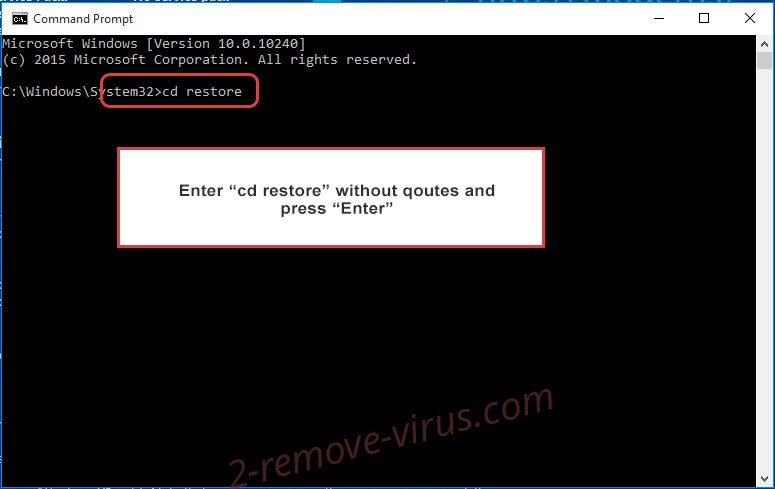
- Type in rstrui.exe and press Enter.

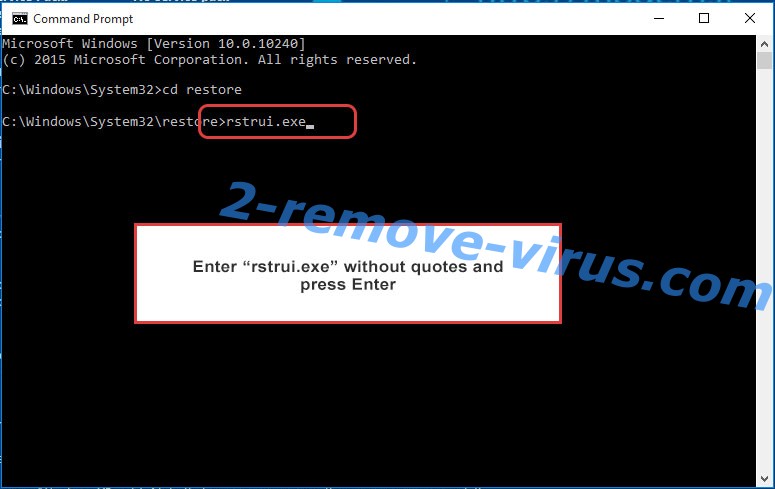
- Click Next in the new window and select the restore point prior to the infection.

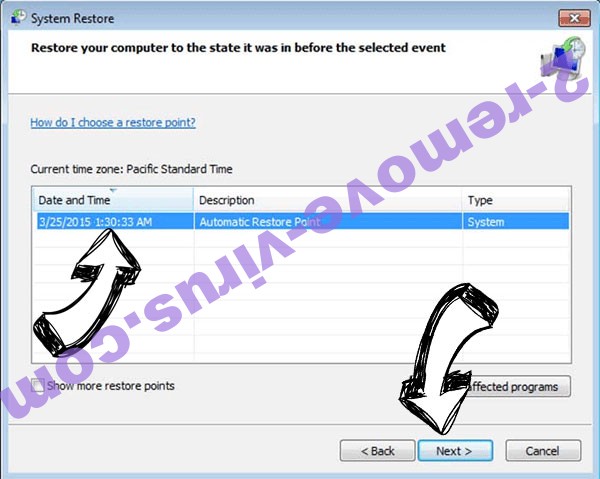
- Click Next again and click Yes to begin the system restore.

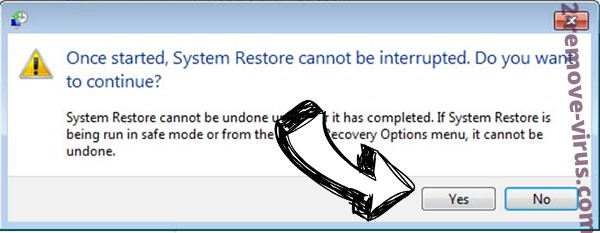
Delete Qqjj ransomware from Windows 8/Windows 10
- Click the Power button on the Windows login screen.
- Press and hold Shift and click Restart.


- Choose Troubleshoot and go to Advanced options.
- Select Command Prompt and click Restart.

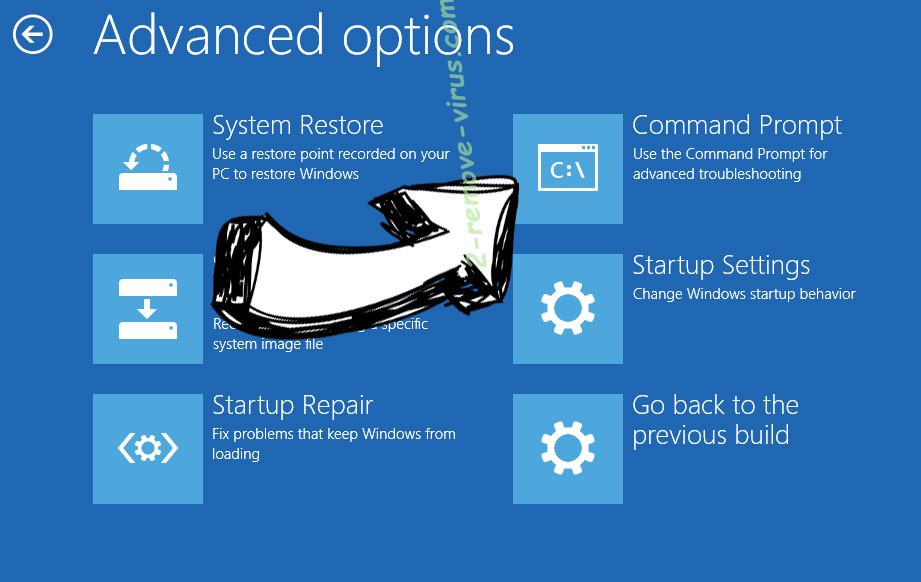
- In Command Prompt, input cd restore and tap Enter.


- Type in rstrui.exe and tap Enter again.


- Click Next in the new System Restore window.

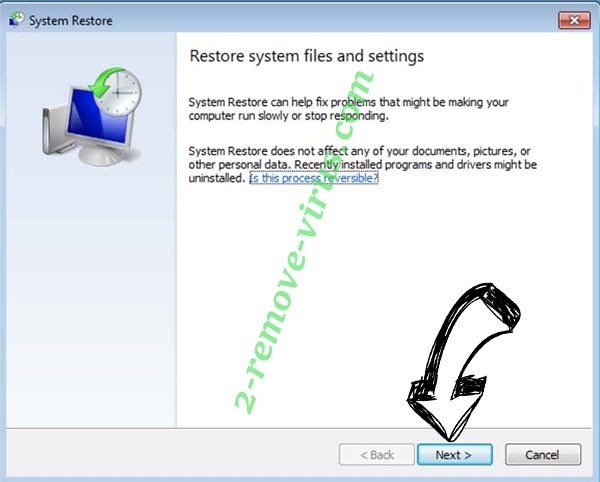
- Choose the restore point prior to the infection.


- Click Next and then click Yes to restore your system.


Site Disclaimer
2-remove-virus.com is not sponsored, owned, affiliated, or linked to malware developers or distributors that are referenced in this article. The article does not promote or endorse any type of malware. We aim at providing useful information that will help computer users to detect and eliminate the unwanted malicious programs from their computers. This can be done manually by following the instructions presented in the article or automatically by implementing the suggested anti-malware tools.
The article is only meant to be used for educational purposes. If you follow the instructions given in the article, you agree to be contracted by the disclaimer. We do not guarantee that the artcile will present you with a solution that removes the malign threats completely. Malware changes constantly, which is why, in some cases, it may be difficult to clean the computer fully by using only the manual removal instructions.
